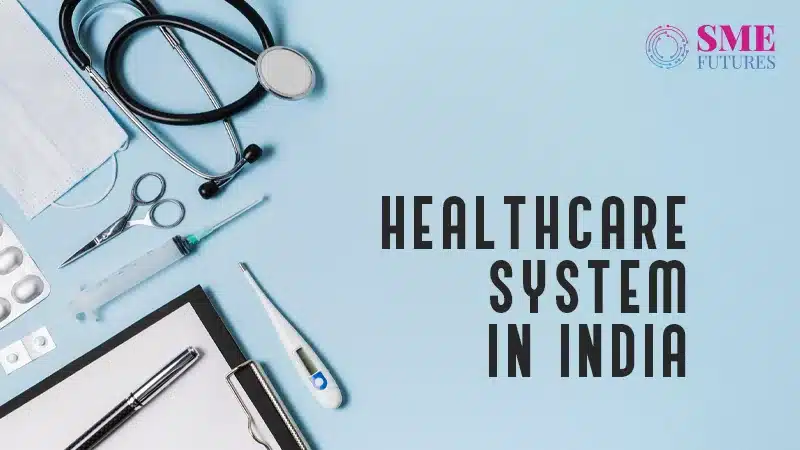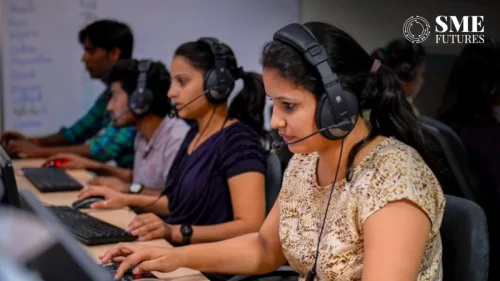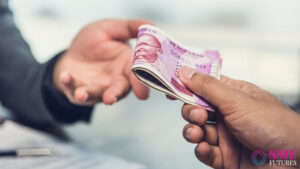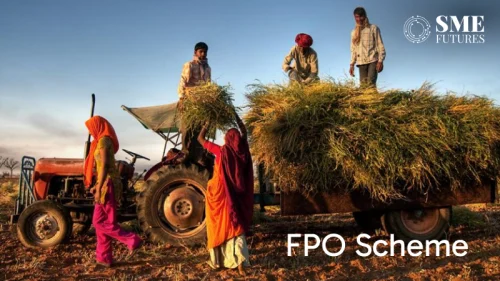The healthcare system is a challenge for many nations across the globe, with no single country having found a perfect solution. Countries like the USA and UK, despite their advanced systems, still struggle with common issues such as staff shortages, funding constraints, persistent inequalities, and the growing demand from an aging population. India is no exception. With these global challenges in mind, I examined India’s health system financing to understand where it stands today and what the future may hold.
India’s National Health Policy India has introduced three National Health Policies (NHP) so far: NHP 1983, NHP 2002, and NHP 2017. The 2017 policy outlines key goals regarding healthcare financing, including:
- Government health expenditure to increase from the current 1.15% of GDP to 2.5% by 2025.
- State health spending to reach over 8% of their budgets by 2020.
- Households facing catastrophic health expenditures to decrease by 25% by 2025.
Then the Section 3 talks about the policy thrust, which includes ensuring adequate investment. Under this section, the policy proposes a potentially achievable target of raising public health expenditure to 2.5% of the GDP in a time bound manner. It envisages that the resource allocation to States will be linked with State development indicators, absorptive capacity and financial indicators. The States would be incentivised for incremental State resources for public health expenditure. General taxation will remain the predominant means for financing care.
The Government could consider imposing taxes on specific commodities-such as the taxes on tobacco, alcohol and foods having negative impact on health, taxes on extractive industries and pollution cess. Funds available under Corporate Social Responsibility would also be leveraged for well-focused programmes aiming to address health goals.
Economic Survey 2023-24
Since the 2017 National Health Policy, India’s healthcare landscape has evolved, as evidenced by the latest Economic Survey. I found this interesting table in Chapter 7 Social Sector: Benefits that Empower.
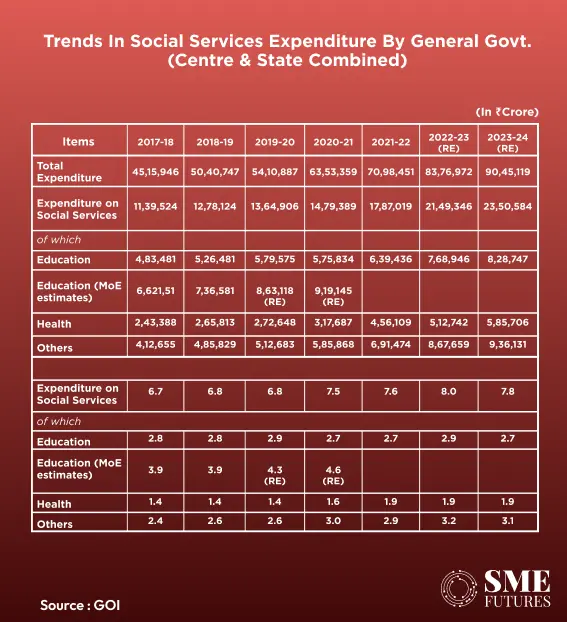
Expenditure on ‘Health’ includes expenditure on ‘Medical and Public Health’, ‘Family Welfare’, and ‘Water Supply and Sanitation.
While the survey highlights progress, the most recent data available from the National Health Accounts (NHA) covers the fiscal year 2019-20. Then there is section on National Health Accounts in section 7.41. Over the past few years, healthcare has become more affordable and accessible for the general public, as noted by the National Health Accounts (NHA) estimates. The latest NHA (for FY20) show an increase in the share of Government Health Expenditure (GHE) in the total GDP as well as the share of GHE in Total Health Expenditure (THE). Surprisingly latest NHA details are available only till FY 20. However, they still make interesting reading.
National Health Accounts 2019-20
This excellent document was prepared by the National Health Systems Resource Centre under the Ministry of Health and Family Welfare. It follows the System of Health Accounts 2011 (SHA 2011) guidelines. SHA 2011 is a global standard framework for producing health accounts supported by WHO. Here are some excerpts.
For the year 2019-20, Total Health Expenditure (THE) for India is estimated to be Rs. 6,55,822 crores (3.27% of GDP and Rs. 4,863 per capita). THE constitutes current and capital expenditures incurred by Government and Private Sources including External/Donor funds. Current Health Expenditure (CHE) is Rs. 5,93,659 crores (90.52% of THE) and capital expenditures is Rs. 62,163 crores (9.48% of THE). Capital expenditures are reported for all sources of Government (Union Government is Rs. 22,923 crores; State Government Rs. 38,951 crores; external donors Rs. 289 crores).
Government Health Expenditure (GHE) including capital expenditure is Rs. 2,71,544 crores (41.41% of THE, 1.35% GDP, and Rs.2,014 per capita). This amounts to about 5.02% of General Government Expenditure in 2019-20. Of the GHE, Union Government’s share is 35.8% and State Governments’ share is 64.2%. Union Government’s Expenditure on National Health Mission is Rs. 40,482 crores, Defence Medical Services is Rs. 14,690 crores, Railway Health Services is Rs 5,043 crores, Central Government Health Scheme (CGHS) is Rs. 4,852 crores, and Ex-Servicemen Contributory Health Scheme (ECHS) is Rs. 5,180 crores. Expenditures by all Government Financed Health Insurance Schemes combined are Rs. 13,809 crores.
Household’s Out of Pocket Expenditure on health (OOPE) is Rs. 3,08,727*** crores (47.07% of THE, 1.54% of GDP, Rs. 2,289 per capita) Private Health Insurance expenditure is Rs. 45,838 crores (6.99% of THE).
Who contributes to current health expenditure?
Of the Current Health Expenditures (CHE), the Union Government’s share is Rs. 72,059 crores (12.14% of CHE) and the State Governments’ share is Rs.1,18,927 crores (20.03% of CHE). Local bodies’ share is Rs. 5,844 crores (0.99% of CHE), Households’ share (including insurance contributions) is about Rs. 3,51,717 crores (59.24% of CHE, OOPE being 52.0% of CHE). Contribution by enterprises (including insurance contributions) is Rs. 32,709 crores (5.51% of CHE) and NGOs is Rs. 9,099 crores (1.53% of CHE). External/donor funding contributes to about Rs. 3,304 crores (0.56% of CHE).
Who provides healthcare services?
Current Health Expenditure (CHE) attributed Rs. 1,02,579 crores to Government Hospitals (17.28% of CHE) and Rs. 1,69,194 crores to Private Hospitals (28.50% of CHE). Expenditures incurred by other Government Providers (incl. PHC, Dispensaries, and Family Planning Centers) is Rs. 48,374 crores (8.15% of CHE), Other Private Providers (incl. private clinics) is Rs. 25,109 crores (4.23% of CHE), Providers of Patient Transport and Emergency Rescue is Rs. 20,879 crores (3.52% of CHE), Medical and Diagnostic laboratories is Rs. 22,765 crores (3.83% of CHE), Pharmacies is Rs. 1,31,727 crores (22.19% of CHE), Other Retailers is Rs 725 crores (0.12% of CHE), Providers of Preventive care is Rs. 33,555 crores (5.65% of CHE). About Rs. 26,976 crores (4.55% of CHE) are attributed to Providers of Health System Administration and Financing and other healthcare providers (not classified elsewhere) is Rs. 11,776 crores (1.98% of CHE).
What services are consumed?
Current health expenditure attributed Rs. 2,01,558 crores to Inpatient Curative Care (33.94% of CHE), Rs. 1,14,548 crores to outpatient curative care (19.29% of CHE), Rs. 2,915 crores to Day Curative Care (0.49% of CHE) Rs. 20,879 crores for patient transportation (3.52% of CHE), Rs. 23,983 crores to Laboratory and Imaging services (4.04% of CHE), Rs. 1,09,835 crores to Prescribed Medicines (18.50% of CHE), Rs. 20,581 crores to Over the Counter (OTC) Medicines (3.47% of CHE). Therapeutic Appliances and Medical Goods of about Rs. 725 crores (0.12% of CHE), Preventive Care of about Rs. 60,250 crores (10.16% of CHE), and others of about Rs. 12,895 crores (2.17% of CHE) also constituted current health expenditure. About Rs. 25,490 crores (4.30% of CHE) are attributed to Governance and Health System and Financing Administration.
Total Pharmaceutical Expenditure is 35.11% of CHE (includes prescribed medicines, over-the-counter drugs, and those provided during an inpatient, outpatient, or any other event involving contact with health system). Expenditure on Traditional, Complementary, and Alternative Medicine (TCAM) is 4.36% of CHE.
Current Health Expenditure attributed to Primary Care is of around 48.0%, Secondary Care of 32.5%, Tertiary care of 13.5% and governance and supervision of 4.3%. When disaggregated; government’s expenditure on Primary Care is 55.9%, Secondary Care is 29.6% and Tertiary Care is 6.4%. Private expenditure on Primary Care is 37.2%, Secondary Care is 36.5% and Tertiary Care is 23.3%.
Here is graphic summarising above data.
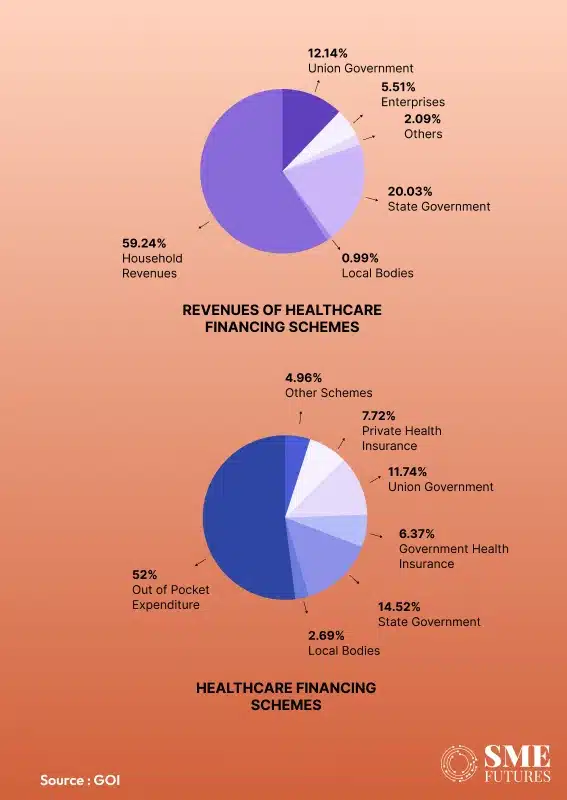
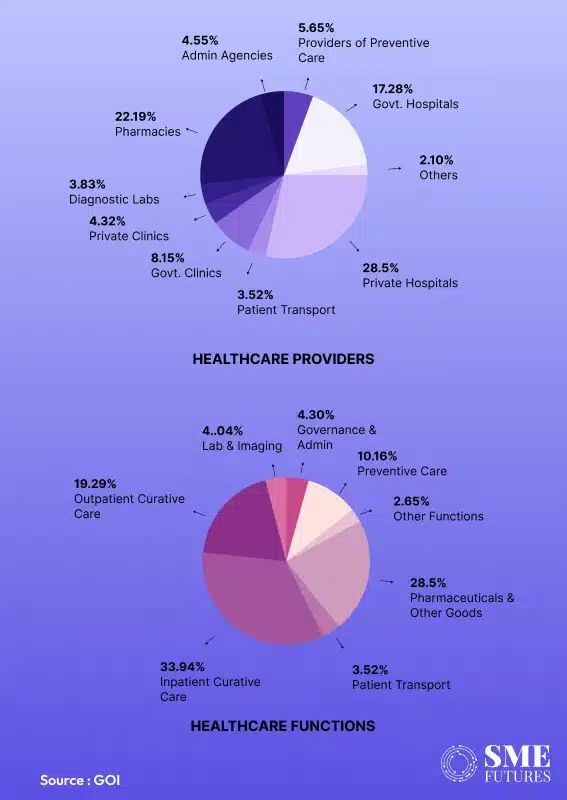
I know this is too much data to digest so here are the key points.
- Current Health Expenditure (CHE) is Rs. 5,93,659 crores
- Of the Current Health Expenditures (CHE), the Union Government’s share is Rs. 72,059 crores (12.14% of CHE) and the State Governments’ share is Rs.1,18,927 crores (20.03% of CHE). Local bodies’ share is Rs. 5,844 crores (0.99% of CHE)
- Of the Current Health Expenditure (CHE) of Rs. 5,93,659 crores households’ share (including insurance contributions) is about Rs. 3,51,717 crores (59.24% of CHE)
- Current Health Expenditure (CHE) Per capita is Rs. 4,402 of which 60% or Rs. 2607 was contributed by individuals.
The last point is really the most important. Citizens bear 60% of the healthcare cost in India.
Union Budget 2024-25
In India, states are responsible for public health and sanitation. This includes public hospitals and clinics. The Ministry of Health and Family welfare formulates a broader policy on public health, such as the National Health Mission. The Ministry of two departments: (i) Health and Family Welfare and (ii) Health Research. The Department of Health and Family Welfare funds the National Health Mission. Under the scheme, states are funded to meet targets on health outcomes, such as maternal health and infant mortality. The Department also regulates medical education, and funds certain medical colleges, such as AIIMS. It also implements initiatives to improve human resources in health. The Department of Health Research funds initiatives in medical research. Total health expenditure includes spending on medicines, insurance, hospitalisation, consultation and health infrastructure.
In the 2024-25 budget Rs 90,659 crores is the allocation for healthcare. It is a 12.93% increase over the previous year. However total Government expenditure (centre plus states) is approximately 2.2% of GDP, below the global average. In comparison, the United States allocated 17.9% of GDP to public health in 2022, China 6.6% in 2021, and Brazil 9.2% in 2021.
Of the Rs 90,659 crores the Department of Health and Family Welfare has been allocated 97% of the Ministry’s allocation and the Department of Health Research has been allocated Rs 3,002 crore.
The above data provides a bird’s eye view of healthcare financing in India. In summary.
- The states are responsible for last mile delivery so we can expect to see large state wise variations.
- There is a large government healthcare system which we suspect is mostly of poor quality on which the poor are dependent.
- There is also a large private healthcare system which caters to the rich.
- Central Government employees are well covered.
As we have seen the citizens bear 60% of the healthcare cost in India but the quality of service is indifferent. This is actually a huge opportunity for entrepreneurs to innovate and provide more effective healthcare delivery solutions. Health tech and digital heath solutions are a very hot area.

